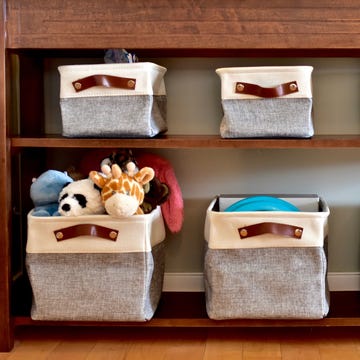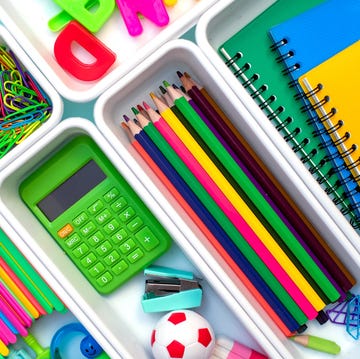It’s 1995. I’m riding on the bus, with a book. I’m in the car on the way to gymnastics practice … with a book. I'm on a plane, on the porch, under the basement stairs … all with a book. Fast forward to adulthood, and you can imagine my distress when I have five kids, none of which have any plans in the near future to touch a book unless they literally have to. How did this happen? And what’s a parent who poured through the Babysitter’s Club and Boxcar Children series like they were viral YouTube videos supposed to do?
It’s not just my offspring — even before the pandemic, kids’ interest and performance in reading was slipping. A 2022 report by Scholastic found that kids’ reading frequency and enjoyment declines as they age. Of the kids ages 12 to 17 who were surveyed, 41% said they read less than one book a week and 53% didn't like reading at all.
A 2021 Pew Research report found that 42% of 9-year-olds reported reading for enjoyment, a decrease from 53% in both 2012 and 1984. For 13-year-olds, the data showed that 29% of students said they never read for fun — an increase from 8% in 1984. In short, the bookworms are getting fewer and further between.
Why Reading Is Essential for Kids
Many times I’ve felt like throwing in the towel when it comes to trying to help my kids love reading. But then I remember the extensive benefits of reading, for both physical and emotional health as well as intelligence, and continue to trudge along through their protests.
The 2022 Scholastic report also found that kids within that same 12 to 17 age group had better mental health if they were frequent readers, with 19% of frequent readers feeling lonely, compared to 30% of infrequent readers. When your elementary school teachers told you books were friends, they weren’t kidding! And in a world of social media drama, most kids could use such friends.
Books transport kids beyond their circumstances and immediate environment, immersing them in cultures and adventures they might not otherwise be able to imagine. And reading to children from an early age is a research-backed way to improve language development and cognitive capacity; improve empathy and emotional awareness; and even just to bond with them.
So, why do kids hate to read? Probably for the same reason they hate to eat broccoli — because they think they “have to.”
How Reading Became Such a Battle
As a former middle school and high school English teacher, I had front-row seats to this dilemma that plagued teachers, parents, and students alike. If you’ve ever had to hand a 16-year-old a copy of Homer’s The Odyssey to hang out with all summer break on their way out of school for the last day, you’d know the confused agony and dread on their faces.
“We believe that kids — and people in general — naturally love to read. If that's no longer true, it's typically because they haven't yet found the right book, may struggle with their reading skills, and/or may have experienced adults making reading less fun by quizzing them on their reading or otherwise passing judgment on it,” says Felix Lloyd a former Washington, DC Teacher of the Year and the founder of Beanstack, a gamified reading program. He adds that quizzes have made reading less fun for all readers and have been especially discouraging for kids who struggle with reading. He intentionally removed them from his programming when he created it.
But it’s not just quizzes themselves that are a struggle — it’s the fact that some kids didn’t learn to read to begin with. Education curriculum theory has vacillated between traditional phonics lessons and something called “whole language learning,” which some have referred to as the reading “war.” Phonics involves students learning letter sounds, whereas whole language learning teaches them the meaning of the complete word, not to be broken down into parts of a word to be decoded. Recently, experts have found serious flaws in whole language learning, and kids from schools used that curriculum may not have been taught effective strategies for reading. (For those who haven’t caught the reading bug because they aren’t understanding phonetics, some parents turn to resources on their own like Siegfried Engelmann’s book Teach Your Child to Read in 100 Easy Lessons.)
Ally Kirkpatrick is an author and the owner and creative director of Old Town Books, an independent bookstore in Northern Virginia. She recently expanded her store to include Old Town Books Junior, a space dedicated to igniting the joy of reading in kids. She says teachers have boxes they need to check in terms of curriculum, topics and time periods. “That can sometimes be a little tricky, because it’s as if everything about reading is associated with school,” she says.
What Parents and Caregivers Can Do About It
I plant books around my house to be discovered, and my kids wonder how they get there. My oldest moves them aside like his lukewarm broccoli on his dinner plate, but my second son — he notices. I’ve seen him pick these books up with some intrigue, and even crack them open. I think he reads a bit of them at night in his room, but I wouldn’t dare catch him doing so, for fear my obvious joy would make him instantly hate it. Luckily, experts have tried and true tips for infusing a love of reading into our kids’ lives and environments.
Start with graphic novels and other fun reads.
“You have to be a little creative,” Kirkpatrick says, warning parents that graphic novels might not satisfy parents or teachers, but these image-based books may be less intimidating to kids than other books. Combine this with a niche interest the child has, such as soccer, and then look for books with short chapters, lots of white space or graphics, she advises.
“Put aside any preconceived notions of what reading is,” she adds. This might be easier said than done at first, if you're a parent who is trudging through yet another book about the grossest reptiles or the Guinness Book of Records from a decade ago. But when kids are allowed to guide their own reading journeys through books that interest them, even if they are reading a commercial cranked-out series or that same old Animorphs book again, it is still reading. And reading is the goal.
Kirkpatrick says not to write off books that are slightly below grade or age level if they match a specific interest or ability. Adult readers, you get this, right? Sometimes at the end of the day you want to zone out with a fun, easy book, not navigate intense topics and convoluted clauses “for enjoyment.”
Check for learning deficits and conditions preventing reading success.
“After two years of preschool and a repeat of kindergarten, my son could hardly remember his alphabet,” says Kate Wehr, a Montana mom of five. “He wouldn't even look at the letters on the paper or the screen without a fight. We had been dealing with quite a few things up to that point, but I finally convinced our school district to have him tested.” She says the results were clear — ADHD, working-memory deficits, and dyslexia.
“Now he is 10, and reading is still a daily struggle for us and we're nowhere near grade level, but at least now we have an understanding as to why, and we've put new academic supports in place,” she adds. “If your child truly hates reading and you're both exhausted and frustrated over it, please investigate to make sure they don't need extra help.”
Like Wehr, other parents can consider testing children who may be struggling with barriers to reading that they might not know about, so they an get additional educational support at home and school.
Write to read.
If your kid hates reading, it doesn’t necessarily mean they hate writing. And, as experts point out, writing requires reading, and the two tasks are inherently intertwined in the best ways. Linda Rief is a mom, grandmother, author, and a retired 8th-grade teacher in Durham, New Hampshire. She remembers encountering a colleague’s granddaughter, age 4, who had written a book. Rief asked her to read it aloud.
“She wanted to read it because she had written it,” she says, noting that the girl only had to stop once to ask how to read one of her words. “We can read without writing, but we cannot write without reading. If we really want our children to be the strongest readers they can be, they need to be given opportunities to write.”
Luckily for parents, this is a simple task. “Even for the youngest children, simply having sheets of blank paper, colored index cards, colored pencils, crayons, and a stapler are all they need,” she says. Before long, the stories will pile up, next to the classic kids’ books you read them. They’ll begin to ask themselves about other writers’ craft as they read, wondering “How’d the author do that? How’d she make me think this way? Or feel this way?” she says.
Create an irresistible reading nook with your kids.
It doesn’t have to be elaborate or expensive, but a quiet, distraction-free and super-cozy reading nook can be just the ticket. A simple blanket fort and flashlight for younger kids, or a special chair for older kids carves out a space for the activity at home. Hopefully, it can be an electronic-free space.
“With devices, video games and social media at every turn, reading can feel less appealing. Help your child by creating a distraction-free zone for reading,” says Cari Teske, director of media services at the Iowa education agency Central Rivers AEA in Cedar Falls, IA. “Putting down devices and giving your child one-on-one attention can help them focus and feel supported.”
Use tech to your advantage — don’t write it off as the enemy.
However, Teske adds that, in the reading struggle, tech shouldn’t be cut out completely. AI tools can generate prompts and story ideas, and reading on ChatGPT is still reading (though it shouldn’t replace books entirely). For example, she suggests, ask AI:
“Create a story about a dog and his two friends, Pig and Camel. They go on some crazy adventures while driving across the United States. Have them stop at the Statue of Liberty and the Grand Canyon. Write it at a third grade level and make it four paragraphs long.”
Then say, “Now make the story funny.”
Then, “Now make it sound like a pirate is telling the story.”
“Keep adjusting the prompt to create and read your own personalized story,” Teske suggests.
Parents and teachers can look to AI tools that add guardrails to ensure that the content is appropriate, such as Hello Wonder, which allows parents to input their own values and goals for their kid, and students to input their interests.
In addition, following along with an audiobook while learning to read can increase a child's confidence. Teachers are often familiar with the success they witness with the use of strategies that integrate both — such as “Reading While Listening” (RWL) — which helps kids overcome gaps in their word knowledge of specific words, and can increase their reading engagement and enjoyment. In addition, listening to a read aloud, whether it’s a parent or teacher reading or an audio book can model for students the intonation skills readers utilize.
When all else fails, like potty training a kid with M&M’s, we resort to bribery. Kirkpatrick says you can also pair reading and screen time, such as “five minutes of reading before screen time,” and then kids often get hooked and read longer.
Don’t be above a bribe or a challenge
There’s a reason Lloyd’s program is based on games, challenges, and reading streaks — gamification is way more fun for kids than reading logs and tests. A recent essay in the New York Times was titled “I Paid My Child $100 to Read a Book.”
I figured if I pay my kids to do extra chores, why not try it for reading extra books? Sadly, it failed miserably for my reluctant readers, but for the essay author’s daughter, it was “the best money ever spent."
Whether or not your kid can be bribed, helping them access the magic portal that is a book might take more, well, creativity. Kirkpatrick says, “You’re not going to talk them into loving books. You have to let them discover it.”
Alexandra Frost is a Cincinnati-based freelance journalist and content marketing writer, focusing on health and wellness, parenting, education, and lifestyle. She has been published in the Atlantic, Glamour, Today’s Parent, Reader’s Digest, Consumer Reports, Women’s Health, and National Geographic. She spends her “free” time with her five kids under age 8, and testing lots of products. To connect or read more of her work please visit alexandra-frost.com or follow her on social media: Twitter Instagram Linked In.


















